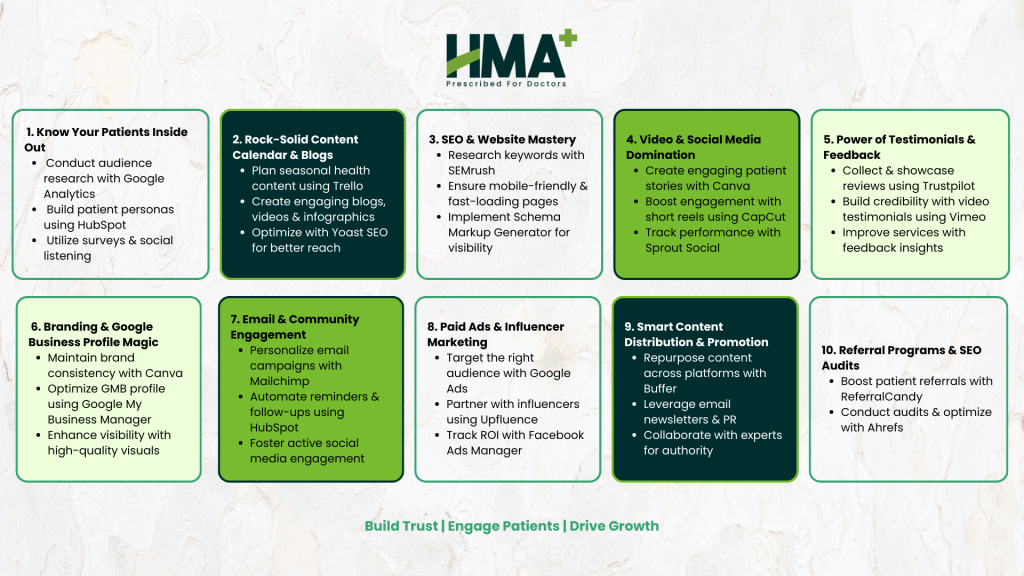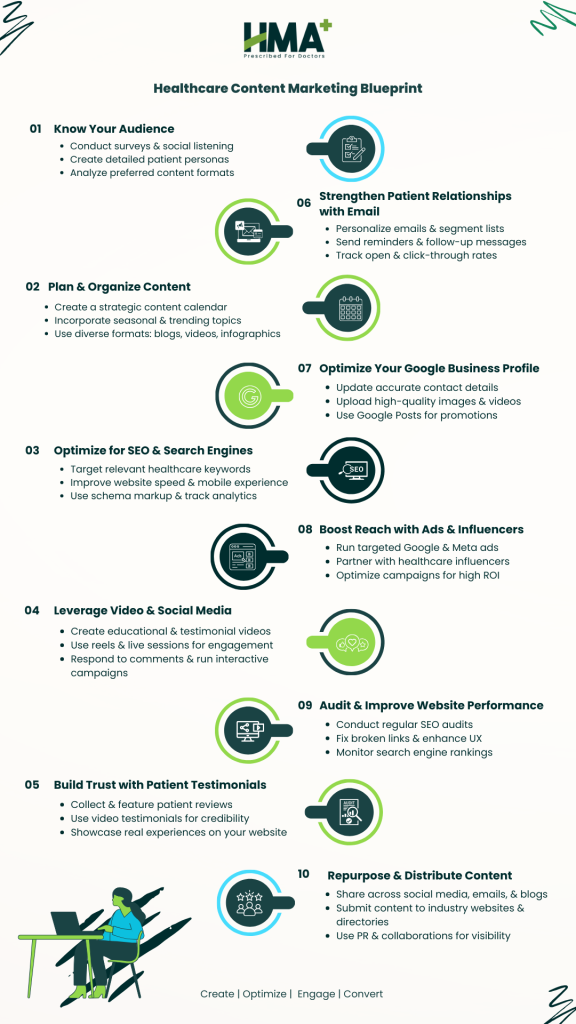
Understanding each marketing channel, aligning a unique strategy for each one for your brand, and satisfying your target audience requirements can be challenging if you don’t have a clear marketing plan. If you make one wrong choice in your marketing strategy, you risk losing your audience’s trust and the brand’s credibility to a large extent.
But what if you had a roadmap, a blueprint to guide your content strategy? That’s precisely what we’re offering. In this article, we will guide you through Content Planning Tips for Healthcare Campaigns that resonate with your target audience.

Go beyond basic demographics. Understand your target audience’s values, beliefs, and pain points, and always align your marketing strategy from the customer’s perspective. Create patient personas representing different segments of your audience.
Use surveys, focus groups, communities, and social listening to gather deep insights about your target audience. Analyze which social media platform they use more often and their preferred content formats. This granular understanding allows for highly targeted and effective messaging.
Incorporate content on seasonal health topics, awareness months, and practice-specific events into your content calendar. Plan for different content formats, such as blog posts, videos, infographics, and social media updates, and be aware of current social media trends. Use project management tools to create content, streamline workflows, and track progress. This ensures a steady flow of relevant, timely content.
Prepare a content marketing strategy that aligns with your practice’s specialties and target audience. Cover topics like preventive care, treatment options, and patient education. Incorporate expert opinions, research findings, and real-life patient stories.
Optimize blog posts for long-tail keywords and internal linking to rank higher on Google-like search engines. Improve reader engagement through comments and social sharing and connect with them by responding to their comments. A well-maintained blog builds credibility and attracts organic traffic.
Conduct thorough keyword research to identify relevant search terms. Optimize website content, meta descriptions, and image alt text for targeted keywords. Build high-quality backlinks from reputable websites. Ensure your website is mobile-friendly in terms of user experience, loads quickly, and has a booking engine.
Use schema markup to enhance search engine understanding of your content. Regularly monitor your website’s performance using analytics tools. Good search engine optimization drives qualified leads to your practice.
Prioritize mobile-first design principles. Ensure your website adapts seamlessly to different screen sizes and resolutions. Optimize images and videos for mobile devices. Use clear and concise navigation menus. Implement touch-friendly elements and fast loading times.
Test your website on various mobile devices and browsers to ensure it works smoothly on all of them. A mobile-friendly website with a booking engine enhances user experience and improves search engine rankings to a large extent.
Need to build a patient-friendly website for your healthcare business.
Read our blog on: patient-friendly website features for an exceptional experience.
Integrate patient portals, online appointment scheduling, and virtual consultation options. Provide easy access to patient education materials and FAQs. Use clear and concise language. Ensure your website is ADA-compliant and accessible to all users. Incorporate patient testimonials and success stories. A patient-centric website enhances engagement and satisfaction greatly.
Create content, including educational videos, patient testimonials, and behind-the-scenes glimpses. Use high-quality visuals and audio. Optimize videos for different platforms and devices. Incorporate closed captions and subtitles for accessibility.
Promote videos on your website, social media, and YouTube through paid advertising. In today’s digital era, Video is a powerful tool for conveying complex medical information in an engaging way.

Use animation and graphics to explain medical procedures and treatments as simply as possible. Feature patient stories and interviews to build emotional connections. Showcase your practice’s facilities and equipment.
Create short, shareable videos in the form of reels for social media platforms to improve social media presence. Visuals are compelling and can significantly enhance patient understanding and engagement.
Collect testimonials from satisfied patients through surveys, interviews, and online reviews. Obtain written consent before sharing testimonials. Feature testimonials on your website and social media, which increases brand credibility significantly. Use video testimonials for added impact. Authentic testimonials build trust and credibility.
Implement feedback mechanisms such as online surveys, patient portals, and social media monitoring. Analyze feedback collected from trustworthy sources to identify areas for improvement in patient satisfaction.
Respond to patient reviews and comments in a timely and professional manner to make them feel they are considered. Proactive evaluation improves patient experience.
Develop content that addresses common patient concerns and questions. Provide practical tips for managing health conditions and maintaining wellness. Use clear and concise words, and avoid using complex medical terms.
Repurpose your content in different formats, such as LinkedIn posts, blog posts, infographics, and videos. Tailored content resonates with patients.
Categorize your email list and subscribers based on patient demographics and interests to ensure each subscriber’s needs are satisfied. Personalize email messages with patient names and relevant content.
Use email automation tools to send appointment reminders, follow-up messages, and promotional offers to each subscriber’s inbox weekly. Track email open and click-through rates to know what email content works. Email marketing fosters direct communication.
After understanding what the user needs, create a healthcare social media strategy that aligns with your target audience and solves a problem for them. Share informative content, engage in conversations, and run interactive campaigns to provide useful information to your followers.
Use social media analytics and third-party tools to track performance and optimize content. Reply to comments and messages promptly to understand what the user needs and also to increase the user engagement. Social media builds community.
Create your own brand identity that includes your logo, color palette, fonts, and messaging. Apply consistent branding across all platforms and marketing materials. Use a consistent tone of voice and brand personality. Consistent branding reinforces your reputation.
Optimize your Google Business profile with accurate contact information, hours of operation, and patient reviews to make your business profile visible to more people and build brand credibility.
Upload high-quality photos and videos of your practice. Respond to patient reviews and questions. Use Google Posts to share updates and promotions. Google Business increases local visibility.
Create dedicated landing pages with the user in focus for specific campaigns and services. Use clear and compelling headlines and calls to action. Optimize landing pages for targeted keywords. Ensure landing pages are mobile-friendly and load quickly—track landing page performance using analytics tools.
Create content and repurpose it for each social media platform, online communities, and industry websites. Use email marketing and newsletter campaigns to distribute content to your subscriber’s inbox every single week.
Collaborate with influencers and partners to expand your reach—track content distribution metrics to measure effectiveness. Effective content distribution maximizes impact.
Use paid advertising like Google and Meta ads to reach targeted audiences—partner with healthcare influencers to promote your content. Submit content to relevant online publications and directories. Use public relations to generate media coverage. Strategic promotion amplifies reach.
Use Google Ads to target specific keywords in your sector and demographics to rank higher on search engines. Run social media ads on platforms like LinkedIn, Facebook, and Instagram. Use retargeting to reach website visitors who haven’t converted. Track ad performance and optimize the ad campaigns for maximum ROI. Paid advertising reaches potential patients.
Identify healthcare influencers who align with your brand values and target audience. Collaborate with healthcare influencers to create sponsored content and social media posts—track influencer campaign performance using analytics tools. Influencer marketing builds trust.
Develop a referral program that rewards patients for referring new clients. Provide referral forms and marketing materials to patients. Track referral sources and measure program effectiveness. Referral management expands your patient base.
Use SEO audit tools like SEMrush or Ahrefs to identify technical issues such as low search engine result page rankings, broken links, slow page speed, and mobile responsiveness. Fix identified issues and optimize website performance. Regularly monitor website analytics and search engine rankings. A healthy website performs better.

In essence, crafting impactful healthcare campaigns hinges on meticulous content planning. By embracing these 22 tips, from deep audience understanding to adaptable scheduling and consistent analysis, healthcare organizations can move beyond simply disseminating information.
They can build genuine connections, foster trust, and ultimately, drive positive health outcomes. Remember, the key is to prioritize patient-centricity, maintain ethical integrity, and continuously refine your approach based on real-world results.
Ready to elevate your healthcare marketing? Please schedule an appointment with HMA; we specialize in healthcare digital marketing services.
Develop patient personas to represent different segments of your audience—tailor content to their specific needs, preferences, and concerns. Use language and visuals that are relevant to each demographic. Conduct audience research in depth to gather insights into their values and beliefs.
Measure Key Performance Indicators(KPI) such as website traffic, engagement (likes, shares, comments), conversion rates (appointments, form submissions), search engine rankings, and social media reach. Use third-party analytics tools to track these metrics and make data-driven decisions.
Refer to trustworthy sources, such as medical journals, government agencies, and professional organizations. Have content reviewed by medical experts.
Create useful video content that explains medical conditions and treatments in simple words. Feature patient testimonials to build trust. Showcase your practice’s facilities and equipment in a detailed manner. Use live video for Q&A sessions and virtual tours. Optimize videos for different platforms and devices.
Consistent branding builds brand recognition, trust, and credibility. Use a consistent logo, color palette, and fonts.